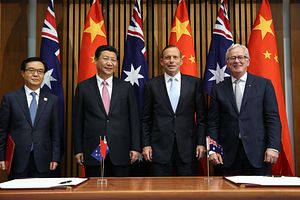Tensions between the United States and China over the Chinese-led Asian Infrastructure Investment Bank (AIIB) are the next embodiment of a hard and soft power battle for economic and political dominance in the Asia-Pacific, and come amid concerns arising from the stalled negotiations for the Trans-Pacific Partnership (TPP). For Australia, a key focus of its foreign policy should be how to balance its economic ties with China and its cultural ties with the United States; appeasing both without getting in the middle of an ugly tug-o-war that forces Canberra to take sides.
Officially, both the U.S. and China have attempted to downplay the gravity of the tussle. Hugo Llorens, U.S. Consul General, in a guest lecture given at the University of Sydney, reassured students that “Australia does not have to choose between the United States and China.” But while it is true that Australia is not at a point where it needs to make such a choice, the reassurance misrepresents the dynamic of Australia being caught in the middle of a power struggle between the worlds two largest economies.
The TPP, drafted in 2005, is a by-product of the U.S. rebalance to Asia. Its intent is to eradicate preferential trade agreements (PTA) in the Asia-Pacific and construct in their place a multilateral trade platform, thus connecting a plethora of geographically incongruent countries at varied levels of development.
Unfortunately, divergent interests and innate agendas have inhibited progress with the deal. Australia’s vision for the TPP lies in developing the regional architecture that will provide a viable gateway to the entire Asia-Pacific; in short, an unrestricted multilateral agreement. In contrast, the U.S. envisions the TPP as an extension of its established bilateral arrangements in the region, with a focus on developing further PTAs with countries it hasn’t already partnered with. The U.S. opposes an unrestricted multilateral agreement because it would lay waste to established protectionist measures – such as long implementation periods and product specific rules of origins – that are a feature of sensitive U.S. domestic industries such as sugar and dairy. A proliferation of PTAs in the region would be counterproductive for Australia because it would close off certain markets, and make others harder to utilize.
China’s exclusion from the TPP has sparked fears in Beijing that the trade deal is a U.S. bid for economic and political dominance in the region – and to strengthen bilateral military alliances. This fear is embodied in China’s ongoing discussions about Free Trade Agreements (FTAs) with ASEAN members as a counter to the TPP.
Australia must serve as the bridge between the U.S. and China and placate fears in Beijing by actively seeking Chinese involvement. After all, a “Trans-Pacific” partnership without China seems insulting to the name.
Readers can speculate as to whether the Chinese-led AIIB is a direct response to insecurities generated by its exclusion from the TPP – or simply a response to the undeniable corollary of Asia’s large-scale need for infrastructure investment. In any case, the facts are stark: China holds comparatively little influence in the Asian Development Bank, the World Bank, or the International Monetary Fund (IMF) compared to Japan (the ADB) and the United States. A Chinese-led international bank will give Beijing greater influence over a region that needs investment of $8 trillion between 2010 and 2020 to keep pace with technological and demographic changes. That in turn will disrupt regional dominance of the U.S. and Japan. It is therefore no surprise that the U.S. and Japan are two lone wolves in expressing concerns over the AIIB’s ability to meet international standards of accountability and governance.
Again, official rhetoric from both the U.S. and China is notably guarded and often deliberately innocuous. Chinese diplomats have noted that the “AIIB will compliment existing global banks.” Yet occasionally the curtain slips and the stakes are revealed: Chinese President Xi Jinping mentioned that the AIIB and the New Silk Road initiatives were an “Asian solution to Asian problems.” Similarly, his U.S. counterpart Barack Obama, in his State of Union Address 2015, stated that “We (America) should write the rules” for the Asia-Pacific.
Australia’s Prime Minister Tony Abbott seems to be trying to appease both powers, (finally) signaling his intention to join the AIIB while still echoing concerns raised by the U.S. and Japan regarding governance, transparency, and creditworthiness. By trying to remain neutral, Abbott has bought himself some time, but if U.S.-China relations deteriorate and tensions rise, neutrality won’t appease either party.
Australia is caught in the awkward position of watching an insidious power struggle between its greatest cultural and military asset, and its greatest economic asset. It must take care to avoid stepping on any toes for the time being, while ensuring that the path it takes is its own and not one determined on the howdah of the U.S. foreign policy elephant or on the back of the Chinese dragon.
Nick Derewlany is a Sydney-based writer.

































